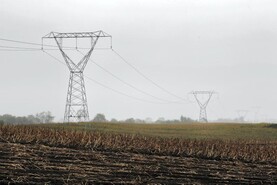An Bord Pleanála last week turned down the application to build an importation terminal for liquefied natural gas (LNG) on the Shannon estuary.
It cited the Government’s concerns about the importation of gas from outside Ireland, which might have been produced using a technique called hydraulic fracturing or “fracking”.
There is no official concern about importing natural gas in principle – there are twin pipelines from Scotland, domestic production from the Corrib field off Mayo is declining and import reliance will rise as Corrib depletes.
It is acknowledged that Ireland will need gas to supplement intermittent renewable electricity generation and space heating in the longer term, perhaps indefinitely.
Not all uses of gas can be substituted out with low-carbon alternatives, even in a longer-term perspective.
Examples include the very heaviest transport vehicles, including big trucks, ships and aircraft, where battery technology is yet to overcome the payload handicap – batteries using stored electricity are fine for cars but too heavy for the bigger vehicles.
The conversion of space heating to electricity is also challenging and the electricity industry cannot be fully decarbonised anyway, since generation must balance demand on a continuing basis.
Generation must be flexible and gas-fired units fill the gaps when renewables like wind are unavailable.
Minister for the Environment, Climate, Communications and Transport Eamon Ryan accepts that while generation from fossil fuels like oil, coal and turf can be phased out fully, Ireland will need gas for the foreseeable future to cover peak loads and the intermittency of renewables.
Corrib gas will be exhausted in 2030, or shortly thereafter, meaning that all supply will have to come through the interconnectors from Scotland.
Undiscovered gas
Perhaps there is more undiscovered gas offshore but exploration is not permitted. Several European countries have been expanding, since the Russian invasion of Ukraine, their capacity to import liquefied natural gas, in which there is a substantial worldwide trade. Exporters include the US and Qatar which have invested in capacity and some European countries, including Germany, have committed to bilateral supply deals.
There are no facilities to import gas in liquid form anywhere on the island of Ireland. An LNG terminal has been on the agenda since the early 2000s and the site on the southern side of the Shannon estuary has much to recommend it, including deep water and location not too far from the existing pipeline network.
Should extra gas-fired generation be required as reliance on intermittent renewables continues to grow, the transmission capacity to export power from the Shannon region is also to hand, since the Moneypoint coal station across the estuary in Co Clare, with its twin high-voltage lines to the Dublin area, will close in due course.
New domestic gas reserves may lurk beneath the waters off Mayo but the official stance is that it is best not to check it out
The coal station is getting old. It was commissioned in 1985, but the high voltage transmission lines will last indefinitely and are a valuable national asset.
The planning board’s refusal of permission for the LNG project at Ballylongford has provoked anger from north Kerry and west Limerick politicians but it is really an issue of national rather than regional significance.
It is conceded that there will be a role for natural gas into the longer term, perhaps at sharply lower annual volumes, and the Government has been encouraging the construction of new peak-load gas-fired units.
Even if efforts to substitute away from other fossil fuels are successful, gas supplies need to be secure.
Exclusive reliance on interconnectors from Scotland creates a risk of supply disruption, as well as exposure on prices. New domestic gas reserves may lurk beneath the waters off Mayo but the official stance is that it is best not to check it out.
The Department of Communications and Energy is of course aware of the supply security issue, as are the general public given the frequency of blackout alerts in recent years.
The Department released a technical report on the matter from the UK consultants, CEPA, last year and a full review has been commissioned and apparently completed. However, it has not been published.
State agencies are quite rightly expected to operate within the confines of the law
An Bord Pleanála nonetheless felt able, in its decision to refuse planning permission for the Shannon LNG project, to attribute its opposition to, among other concerns, the conclusions of this unpublished review.
State agencies are quite rightly expected to operate within the confines of the law.
Had the Shannon LNG promoters sought permission to build a nuclear station, An Bord Pleanála would no doubt have refused on the grounds that there is a prohibition in statute law.
For an independent agency with quasi-judicial functions to ground a decision on inferences about policy from, effectively, a secret report, is disturbing.
It is open to the Shannon promoters to seek judicial review. At a minimum, they can point out that they could source non-fracked gas, or that current imports come from the North Sea, where hydraulic fracturing has been routinely employed.






 This is a subscriber-only article
This is a subscriber-only article










SHARING OPTIONS: